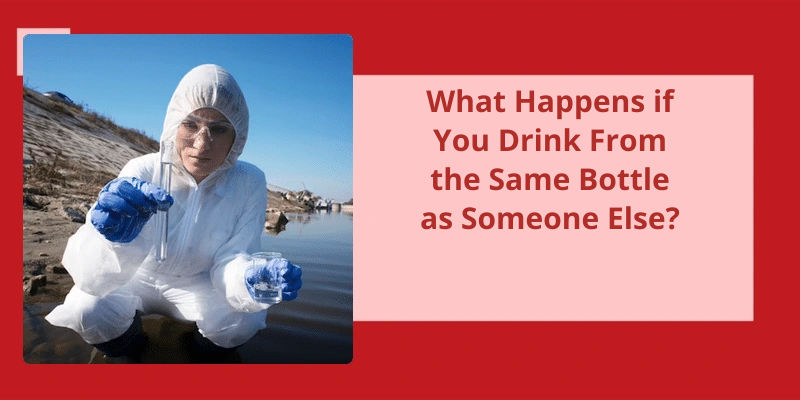Drinking from the same bottle as someone else may seem like a harmless act of sharing, but it comes with potential risks that are oftentimes overlooked. Many people are unaware of the dangers associated with sharing drinks as simple as water bottles. When you drink from the same bottle as someone else, you’re engaging in a behavior known as oral contact. This type of contact involves the transfer of saliva between individuals, which can lead to the spread of harmful germs and viruses. While most people are aware of the common cold and strep throat, the consequences of oral contact extend far beyond these ailments. If you regularly engage in this behavior, it's important to be mindful of the potential risks involved and take necessary precautions to protect yourself and those around you.
Is It Safe to Use Someone Else’s Water Bottle?
Sharing personal items such as water bottles is typically not recommended, as it can lead to the spread of harmful bacteria and viruses, particularly those that are transmitted through saliva or respiratory secretions. Bacteria that are commonly found in the mouth and throat, such as Streptococcus and Staphylococcus, can easily be transferred through sharing, resulting in an increased risk of infection.
Moreover, using someone elses water bottle also exposes you to their personal hygiene habits, which may not meet your own standards. For instance, if someone has a habit of leaving their water bottle out in the sun or not washing it regularly, it can lead to the growth of harmful bacteria and fungi within the bottle, which can then be transferred to your body when you drink from it.
In addition to this, some studies have shown that certain types of bacteria and viruses can survive on surfaces for hours or even days, particularly in warm and humid environments. Therefore, even if someones water bottle appears to be clean and well-maintained, there may still be a risk of infection if the person carrying it’s sick or carrying infectious microorganisms.
There are also concerns about the potential transfer of chemical contaminants through shared water bottles, particularly those made from plastic. Some plastic bottles contain harmful chemicals such as bisphenol A (BPA), which can leach into the water and be ingested by anyone who drinks from it. While most manufacturers have started to make BPA-free bottles, there are still other types of chemical contaminants that may be present in some brands.
If you must share a bottle, it’s recommended that you thoroughly wash and sanitize it before and after use, and avoid touching the bottle neck or mouthpiece with your hands or face. Instead, use a straw or other utensil to drink from the bottle, and be sure to clean it thoroughly between uses.
Taking care of your health is essential, which is why understanding how long you can drink out of the same water bottle is important. Drinking water is essential for our bodies, and choosing to drink from a reusable water bottle is eco-friendly. Nonetheless, you must take into consideration how to properly care for your water bottle to avoid potential health risks. Keep reading to learn more about the recommended maximum time for drinking out of the same water bottle.
How Long Can You Drink From the Same Water Bottle?
However, it’s not necessarily dangerous to drink the water from the same bottle for longer than two days. The website of the Centers for Disease Control and Prevention (CDC) states that “there is no hard and fast rule” about how long you can drink from the same water bottle. The risk of bacterial contamination increases over time, but it also depends on various factors such as the temperature, type of bacteria, and how many times you open and close the bottle.
Some studies have shown that certain types of bacteria, such as E. coli and Staphylococcus aureus, can survive in water bottles for several days or even weeks. However, these studies were conducted in a laboratory setting and may not necessarily reflect real-life situations. Moreover, most people don’t drink directly from the bottle but pour the water into a glass or take sips with a straw, which reduces the risk of oral contamination.
There are some signs that your water bottle might be contaminated and should be discarded. For example, if you notice an off taste or odor, cloudiness, or discoloration, it’s best to err on the side of caution and get a new bottle. Additionally, if youve been sick or suspect that you may have been exposed to a bacterial or viral infection, it’s advisable to avoid sharing your water bottle with others or even drinking from it yourself.
To minimize the risk of bacterial contamination, there are some best practices you can follow when using a water bottle. First, make sure to wash your hands before handling the bottle to avoid transferring bacteria from your hands to the bottle. Second, avoid touching the rim or the inside of the bottle with your mouth or saliva. Third, rinse the bottle with hot water and soap between uses and let it air dry. If you want to disinfect the bottle, you can use a solution of 1 teaspoon of bleach per quart of water or a water bottle cleaning tablet.
The risk of bacterial contamination depends on various factors and may vary from person to person. However, by following some basic hygiene and cleaning practices, you can reduce the risk of getting sick from your water bottle and enjoy your favorite beverage for longer.
How to Properly Clean and Maintain Reusable Water Bottles to Prevent Bacterial Growth
To properly clean and maintain reusable water bottles, it’s essential to wash them thoroughly with soap and hot water after every use. Additionally, avoid using abrasive or harsh chemicals that can damage the bottle or leave behind residue. It’s recommended to use a bottle brush to clean all parts of the bottle, including the cap and nozzle. To prevent bacterial growth, air dry the bottle completely before storing it, and avoid leaving it in a warm or humid environment for long periods.
Source: How long is it safe to reuse a plastic water bottle?..
Conclusion
In conclusion, sharing a bottle or any other form of direct contact involving saliva with another person can have varying health risks. While some of the risks may be more severe than others, it’s important to be mindful of the potential danger associated with sharing. It’s important to always use personal items and avoid direct contact with others to lower the chances of illness. Additionally, good hygiene practices such as washing hands frequently and covering the mouth when coughing or sneezing can help to prevent the spread of these illnesses and safeguard oneself and those around them. Overall, taking precautionary measures to prevent the spread of illnesses is crucial to maintaining good health and preventing the spread of dangerous diseases.






